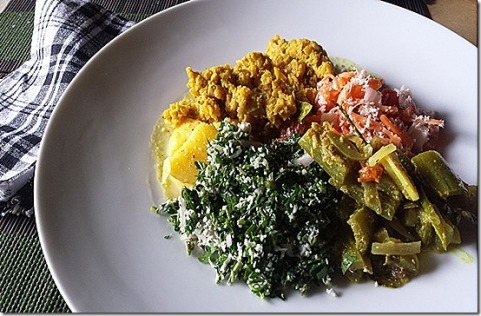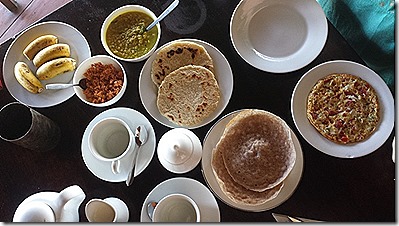“What’s the difference between Sri Lankan food and Indian food?”
This was possibly the most prevalent question from friends and family on return from my honeymoon in Sri Lanka last month.
It’s quite simple really: the fundamentals of Sri Lankan ingredients are rice, coconut and native tropical fruits and vegetables.
(If you ask a local, however, they will invariably state rather playfully that Sri Lankans subsist simply on “Rice and curry”).
The food itself is therefore not as eclectic as the typical Indian dish might be – no sign of any saag paneer, rogan josh or vindaloo but there were certainly many stunningly flavours, interesting textures and very heavy spices (most Sri Lankan food is unapologetically hot).
The information and images in this post provide a culinary snapshot of how myself and my loving new wife experienced this fascinating country.
The Curries, rice and other carbohydrates
The curries of Sri Lanka take the form of chicken, beef, fish or vegetable all served with boiled rice.
Rice flour in Sri Lanka is also shaped into rice flour pancakes (called ‘hoppers’) or rice noodles (‘string hoppers’).
Hoppers are a breakfast staple. These round bowl-shaped pancakes, cooked in a rounded pan (like a miniature wok), are best with an egg fried into the bottom. Made from fermented rice flour, they are used to pick up many of the same curries and accoutrements that rice would, especially the sweetened seeni sambals (sweet caramelised onion).
Bread was commonly served at breakfast. There’s a uniquely Sri Lankan version of roti, made with coconut flour, which forms a thick disk and can be found at breakfast and throughout the day.
Sides, snacks and ‘short eats’

(top left) dhal curry, (top right) grated coconut and carrots, (bottom right) curried aubergine, (bottom left) mallum
Sri Lankan food is served with all sorts of condiments. Pol sambal (spicy, scraped coconut); mallum (a dish of shredded leaves: kale, mustard greens, cabbage with scraped coconut, lime juice, onion, chili, and Maldive fish) and lentil curry (‘Dhal’) were prevalent among these.
Some of our meals were served with ‘Gotu kola’ (pictured right), a small herb which has been used to treat many conditions for thousands of years in India, China, and Indonesia. It was used to heal wounds, improve mental clarity, and treat skin conditions such as leprosy and psoriasis.The herb itself had a strong taste, not unlike watercress – probably with similar quantities of iron, too.
Sri Lankan snacks are usually called “short eats” which consist mainly of samosas and vadai (deep fried chickpea patties) sold in newspaper cones on many of our public train journeys.
Hot, hot, hot!
As previously mentioned Sri Lankan food is known to be very spicy. If you are a foreigner it’s probably worth inquiring as to the level of heat in a dish before you order. Common spices used in Sri Lankan cooking are cumin, coriander, fenugreek, ginger, garlic, turmeric and cinnamon.
Interestingly, black pepper used to be the most powerful spice on the island until peppers arrived on a colonial trade ship.
Where to find Sri Lankan food
Now that I’ve gotten you all excited about Sri Lankan food, here’s the bad news: it isn’t that easy to find elsewhere!
After arriving back in the UK I searched the local libraries for cookery books on Sri Lanka with no joy. Restaurants are not exactly a dime a dozen either – certainly none that I know of in Edinburgh.
Even in Sri Lanka, the best way to eat good, authentic meals is to knock on the door of “rests” (the local version of a guesthouse) and ask them to cook you dinner later that night. Tourist hotels and guesthouses catering to Westerners tend to do watered-down versions of local food or pretty terrible attempts at Western food.
Wherever you find it, the key to enjoying Sri Lankan food is simple: don’t be afraid of strong flavours.



Great post! If you’re looking for a SL cookbook then Charmaine Solomon or Anita Dickman are my go to. They’re a bit seventies – glace cherries feature heavily in the desserts – but are authentic. Or you can go on my blog 😉 hopefully in a few years time Sri Lankan food will be more accessible, with the opening of places like Hoppers in C London and pop-ups like Kothu Kothu.
Congrats to you and your wife, hopefully you can visit Sri Lanka again one day!
Hi Shini, many thanks for your kind comment, and yes we look forward to going back to Sri Lanka. I can’t stop raving about it to friends and family. I shall need to check out the places you’ve mentioned next time I’m in London. Kind regards, Jon